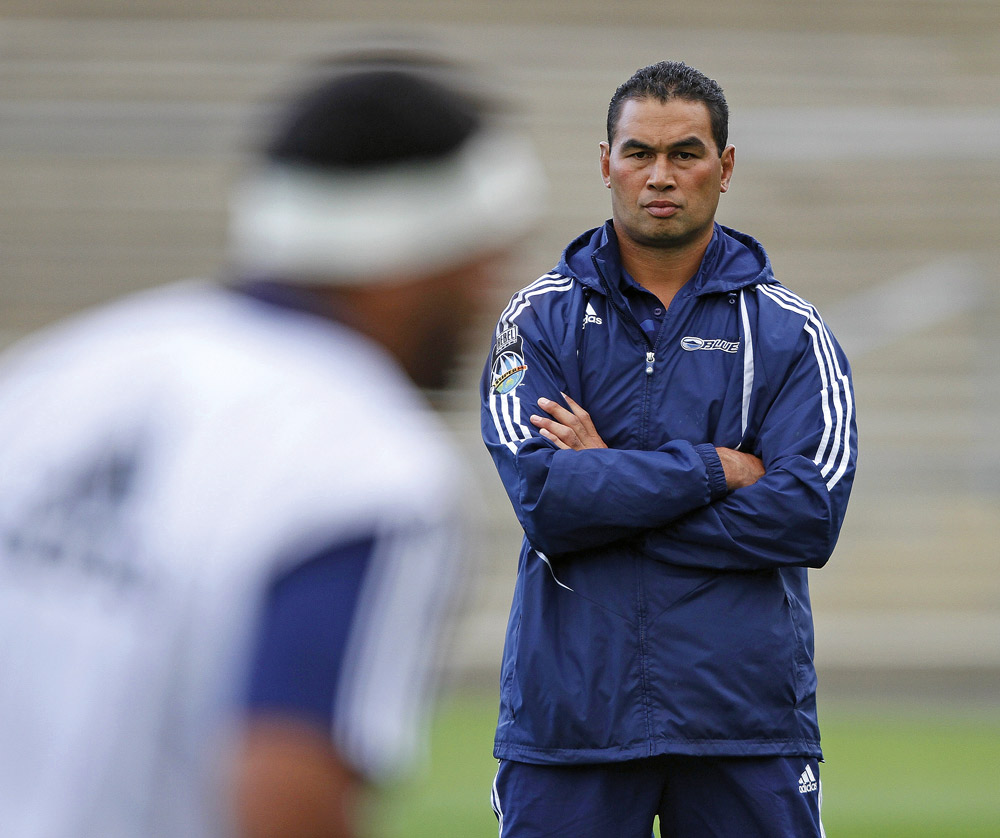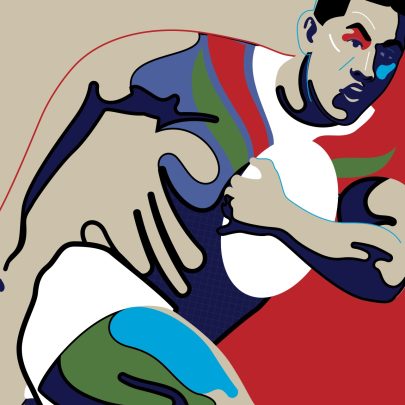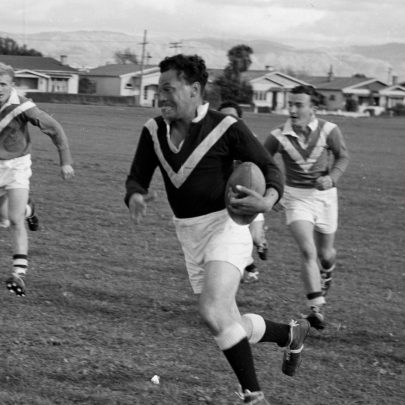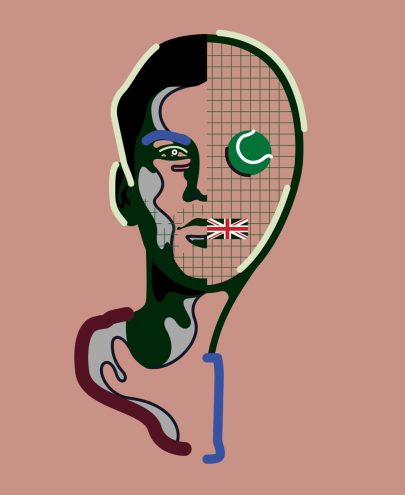Jun 6, 2014 Sport
This story first appeared in Metro, June 2012.
If it walks like a duck and is as low to the ground as a duck, it’s Piri Weepu. On a recent Wednesday afternoon in bright autumn sunshine, New Zealand’s most famous fat athlete waddled his way across the grass to the changing sheds of the Auckland Blues sporting complex, which is actually a shack out the back of the grounds of the Unitec campus.
Great expense has been spared to accommodate the Blues. The paint is chipped, there are banged-up sheets of gib, the bathroom sink could do with a scrub. Strange that players earn executive wages — entry level is $70,000, and All Blacks are guaranteed at least $180,000 — and yet work out of a dump.
Weepu was the first to arrive for training. He was followed by Ma’a Nonu, who followed his own chest — it looked as heavy and massive as a shield of armour. The sheer weight of it threatened to topple Nonu over as he climbed the steps to the changing sheds.
More players arrived, and then head coach Pat Lam. They laughed, squinted into the sun, stood around. Training had to wait; the first order of the day was to feed scraps to the waiting media.
The rugby writers asked informed questions about selection, tactics, groins. I was given five minutes with Anthony Boric and three minutes with Charlie Faumuina, and asked them for their names. I’d never heard of them.
I can report that Boric lives in Grey Lynn and enjoyed his night out at Jersey Boys; Faumuina lives in Manurewa and would rather play poker than listen to music. They both seemed very nice.
They weren’t the right people to explain why it was that their team was where it was, which was bottom, the worst Super 15 rugby franchise in New Zealand, so bad and so traumatised and on such an epic losing streak that even people who knew nothing of rugby were sitting up and taking notice.
I sat up and took notice. I started going to games and hanging around their shack out the back of Unitec, because something rare and amazing was going on with the Blues. Failure is a deeper and more complex experience than winning, and they were failing in public, week after week, in Australia and South Africa and all over New Zealand, including at their home stadium at Eden Park.
Their season in hell, at a glance: lost to the Crusaders, lost to the Chiefs, won against the Bulls, lost to the Stormers, lost to the Hurricanes, lost to the Rebels, lost to the Sharks, lost to the Highlanders, lost to the Reds, lost to the Hurricanes, won against the Lions, lost, hopelessly, to the Crusaders.
Seven losses in a row, 10 so far — this was losing of the highest order, a moment in history, something to be marvelled at, as freakish and wrong as the Titirangi snowflake. “At Titirangi yesterday morning,” the New Zealand Herald famously reported on July 12, 1951, “a single flake was seen to drift down, settle on the ground, and quickly melt.” The Blues were as warped as that cold snap, as broken as another remarkable incident in Auckland’s history — the blackouts of 1996, when the city lost power for five weeks.
Anyone wanting a mere sporting comparison only had to look at that memorable, giddy summer of 2003, when Team New Zealand was whipped 5-0 in the America’s Cup yacht race. In the first race, Dean Barker’s leaky tub took on water, and nearly sank. In the third race, the mast snapped. By the time it broke a spinnaker pole in the fifth race, Barker had established himself in the pantheon of great New Zealand losers. He has been joined by Pat Lam.
Alas, poor Lam. He was that fabled character in the morality stories we tell each other — the nice guy who finishes last.
A proud Samoan, father of five, former schoolteacher, he worships at the evangelical Life Church in Mt Eden and blushes when he swears. “Noble… personable… gentlemanly… dignified,” wrote the rugby press, in one breath; in the next breath, they agitated for his head on a stick.
It was duly delivered, but in a roundabout manner. After the May 4 loss to the Hurricanes in Wellington, where the Blues were outclassed 35-19, the board advertised Lam’s job as head coach for the 2013 season. He will stay with the Blues until then, and possibly afterwards as an assistant coach.
I met him twice at his office. The first time was between the loss to the Reds and the loss to the Hurricanes. He was hanging onto hope. The second time was between the loss to the Hurricanes and the announcement that the board had advertised his job. He’d already been told, but couldn’t make it public; everything he said sounded like a farewell speech.
When I asked him what he said to the players on the Friday night after the Hurricanes game, he said, “I took a big breath, and it was like, ‘All right, we’ve got a bit of picking up here to do again.’ I went into the changing room and made sure I shook all the boys’ hands. It’s making sure you say, ‘Hey, keep your head up, life goes on.’
“I ended up having quite a nice time back at the hotel with some of the senior players. We got a bottle of red wine, and sat there and talked about life and our families, their marriages and kids. I normally try to get to bed early on game night, at 11 or midnight, but we probably stayed up till two or three in the morning. You know, it’s all about relationships. It’s about sometimes having to go around their place for a chat, meet their wives. I know all the names of all their wives. Met them all. Know all the names of their kids. That’s what’s important…”
Just as I was beating a path to Eden Park to watch the Blues make history, thousands of fans were heading the other way. Crowd attendance at the opening game of the season, vs the Crusaders: 30,000. Crowd attendance to watch the Blues vs the Lions, May 11: 12,111. The franchise had anticipated a crowd of 24,000.
“If we were winning games and pressing for a place in the finals, I’ve no doubt we’d achieve our budgets,” said marketing manager Grant McKenzie. “But the one thing we cannot control is the product on the field.”
The Blues had forecast revenues of $5 million ($2 million from sponsorship, and $3 million from ticketing and membership), and a profit of $150,000. “The margins for error are pretty slim. Pretty slim.” He still thinks they might achieve their target, depending on bumper attendances for the remaining home games vs the Highlanders (May 26) and the Chiefs (June 2, at North Harbour Stadium). “It’s touch and go.”
The precarious state of affairs, the deserted stadium — no one saw it coming. In fact, everyone at the Blues approached 2012 with confidence and excitement. Things were on the up and up. In his three seasons as coach, Lam had taken the Blues from eleventh to seventh to fourth. The franchise signed All Black stars Weepu and Nonu.
There were other All Black stars, too, including the inspirational Jerome Kaino, captain Keven Mealamu, and veteran forward Ali Williams. The Blues won all three of their pre-season games. They had an open day at Orakei Domain; 3000 people came, there were balloons, games, sausages.
Weepu arrived fat, Kaino and Mealamu got injured and Williams lost form.
All good, except that Weepu arrived fat, Kaino and Mealamu got injured and Williams lost form. “The acid is on Ali,” Lam continually told the press; the way he played, Williams might as well have been on acid, a lunging, blundering loon, hallucinating in the lineouts. The injury list grew longer. They lost by a single point to the Crusaders. They lost by a single point to the Hurricanes. They lost confidence. They made mistakes, were clumsy, butter-fingered, fraught.
“When I look back at it,” said Lam, sounding like a man peering into fog, “after we lost to the Stormers, if we’d beaten the Hurricanes and not lost in the last minute — that was a killer blow for us. Then we played the Rebels. Lost that one, and all hell broke loose because we shouldn’t be losing to the Rebels. All of that weight, boom!, boom!, got thrown on top of us. From there it just escalated…”
When I went to see them lose to the Reds at Eden Park — 13-0 down in the first seven minutes, unable even to get out of their own half for 18 minutes — they played like men in a state of shock.
The crowd was too numb to rouse itself to anger. It muttered and mumbled, it sucked on $7.50 frankfurters, it put up with the Blues’ gormless mascot, Bluebeard. Finally, one man screeched, “What the fuck, Blues!” They looked capable of losing to anyone. They were dogs in Lam’s manger.
 605 " height="507" />
605 " height="507" />
Lam insisted that he hadn’t lost the dressing room. The problem was that he hadn’t found it. I liked Lam; he was a good man, he was a warm man.
He was given to long ravings. This, from the first minute of our first interview: “You know, I think that anybody, whatever walk of life, all the people you meet, all the wonderful people you meet — mate, you read all the books and biographies, and every single person throughout history will say that strength comes from adversity.
“They’ve been through a tough time and they’ve got through it. Because it’s still a choice. It’s a choice whether you take learnings from it, or people just give up. But all the people that have taken learnings from it have gone on to do great things in their life. And I believe that’s one of the things — while it’s tough, no one likes it, particularly our fans, but more so our players, and you know, constantly as we go though every day, and I meet with different individuals either at their home or — see, this is what I love about coaching.
“Like on a Monday morning, it’s tough. You lose on a Friday night, and then to get everybody back up again, to go through that learning… to watch that happen I see a lot of positives in the way guys are interacting. Because it’s actually through adversity that — I watch war movies, the trenches and the guys in there, and who’s actually got that soldier’s back. And you don’t really know until you’re right in the middle of the battle. And that’s,” he said, “where we are.”
There was a knock on the door. Team manager Bryce Anderson popped his head in, and said to
Lam, “Mochaccino?”
“Oooh yes please,” Lam said.
For a while I thought of Lam as Scott of the Antarctic, magnificent and doomed.
He took a sip, and continued raving. “I’ve been to over 10 weddings of my players, and that’s probably my biggest satisfaction, to be part of a person’s life. You know, only one team’s ever going to win. And that’s sport. But I didn’t get into coaching to say I’m going to win everything possible. Every season I keep checking my coaching philosophy: ‘Am I making a difference?’ Now we’re losing, and I keep checking: ‘Am I making a difference?’
“People say to me, ‘Pat, what’s your goals, how far do you want to go?’ The ultimate goal is to coach the All Blacks. But that’s rugby. My biggest vision is to be 75 years old, God willing, have my wife, my kids, my grandkids all around for Christmas, have the big island feed, give out all the presents.”
I asked what he would say if someone walked in on that happily family scene and said, “What the hell was that all about in 2012, Pat?”
He said, “I’d say, ‘Mate, what a great learning experience that was.’ You know, at the end of this year, what I’ll remember is some of the relationships I’ve built here, because I know that players in this group will go on to do very good things not only in sport but in life. I know that for a fact.”
For a while I thought of Lam as Scott of the Antarctic, magnificent and doomed; the South Pole was his office, with his library of 200 self-help and motivational books, which he pored over even as the walls closed in, the temperature dropped (it snowed), it grew dark (the power went off), and the only sound to be heard was Lam’s voice, wailing like a ghost, telling haunting stories about adversity…
He created a culture at the Blues. It was a culture of a lot of talk about life being sometimes really terrible. I asked assistant coach Bryce Woodward whether the mood of the Blues was sometimes bleak, and he raved, “I shared with the boys a story about my mother. She was born in London and was nine or 10 when war broke out. Then the doodlebugs started coming in, the missiles. That’s bleak. That’s hell. Firestorms. Losing neighbours, property, food — that’s bleak.
“Mum had made arrangements through family connections to be sent out here, to New Zealand. But she got tonsillitis and they wouldn’t let her on the boat. The boat sailed out and it was missiled by a U-boat. Everyone went down with it.
“Mum spent the rest of the war in Wales, getting a visit at best once a month from her parents. That’s bleak. Her parents were in London getting bombed the shit out of, and they got to the point where they were ready to give up. They were ready to start learning German. But then Churchill made his great speech. ‘Never surrender.’
“So. This ain’t bleak. That was bleak.”
Yes, it was very bleak indeed. He said he gave the speech in the dressing room after the Blues lost to the Sharks. How did the players respond? “There was stunned silence.” No doubt. “Then they
lifted their glasses of water and the odd person who had a beer stood up and saluted my mum. So it obviously resonated.”
Blues chairman Gary Whetton said, “There are people who probably won’t be there next year.”
He wasn’t specifically referring to Lam. But after we’d spoken on a Tuesday morning, he told Lam the Blues were advertising for a new coach. He said to me, “Pat’s a man of huge integrity, and you like the guy. But sometimes you might say, ‘Well, there’s like, and there’s success, and they don’t always go hand in hand.’”
Whetton was elected chair in April. He wanted to come across in his interview as decisive, someone not afraid to shake things up. Yes, he said, he was aware that fans were calling for the board to be shaken up. He wasn’t exactly a new broom; wouldn’t he be compromised by existing friendships? I asked him whether he was friends with Blues CEO Andy Dalton. “Colleague,” he said.
He began by saying, “I’m probably my biggest critic.” That seemed unlikely.
I met with Dalton. He had the firmest handshake of anyone in the Blues enterprise, and his skin was drawn tight over his face. There was an antique on the wall — a framed Blues jersey from 2003, the last time they won Super rugby.
Dalton has been in the job since 2006. Only one new All Black has emerged from the Blues in that time, and the closest the Blues have come to a sniff of silverware was making the play-offs, once, in 2011.
I asked him how he rated his performance as CEO. He began by saying, “I’m probably my biggest critic.” That seemed unlikely. There were much harsher critics commenting on the Blues’ own website, agitating for his head on a stick. One fan displayed a banner at Eden Park: SACK THE BOARD. It was torn down by security.
I asked, “Do you think you should step down?”
Dalton said, “I want to turn this around as much as anybody.”
I asked, “Has anyone asked you to step down?”
He said, “I haven’t been asked by the board.”
I asked, “In the best interests of the Blues, don’t you think you should step down?”
He said, “No. No.”
He spoke slowly, and watched his words. But his nerves got the better of him. I asked him about the mood of the team, and he said, “You look very closely for the creeks in the dam. Or the leaks in the dam.”
When the interview finished I said, “You look stunned.”
He said, “I always look stunned.”
But the next step for the Blues is less about departures than arrivals. I met Nick Sheppard, the franchise’s high-performance manager who leads the player development, talent identification and player recruitment strategies for the Blues — in short, the future.
Sheppard signed on in 2009. He overhauled the youth programmes. Now, he said, “We’ve got the most players represented in the New Zealand under-17 programme than any other franchise, the most players in the under-18s and have done for two years, and seven players in the under-20s — it would have been eight, the highest of any franchise, but our hooker broke his foot.
“It’s early days. We’ve got some really good kids coming through, but they’re not just ours by right. We are under threat from the other New Zealand rugby franchises, and we have the Warratahs, Brumbies, and Queensland Reds in our back patch all day, every day. And there’s rugby league, too — not just the Warriors. The Roosters, the Storm, the Sea Eagles, they’re donkey-deep in this area watching schoolboy rugby.
“The theory is, if we can retain and develop our own, they’ve got an affinity to the jersey, and want to play for the team, and some of them will hopefully go on and have illustrious careers for the Blues and maybe become All Blacks.
“They’re not all going to make it,” he said. “Yes, they have to be able to play rugby, that’s a good start, but we’re looking for people strong in character, in discipline, developing a self-awareness as they become young men.” He works closely with Ben Meyer, the Blues’ professional development player.
“The ultimate aim,” he said, “is to grow these young men into players who will win us championships in the future.”
He had a vision. It was cautious but optimistic. It was of a time when the Auckland Blues won games, were among rugby’s elite, challenged for titles. Happier times; but there is a trace of ordinariness in success. The day will come when that extraordinary 2012 season is regarded with awe, when that wild ride — seven straight losses, an expensive fatty at half-back, depressing pep talks about schoolgirls with tonsillitis — inspires a tender, glowing nostalgia.





